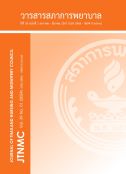Implementing Nurse-Led Case Management Guideline for Vulnerable Children and Their Families
DOI:
https://doi.org/10.60099/jtnmc.v39i01.265472Keywords:
vulnerable children, nurse-led case management, family, multidisciplinary, satisfactionAbstract
Introduction The challenge of vulnerable children in Thailand is on the rise, affecting both urban and rural communities. Collaborative efforts among multidisciplinary teams and community networks that bridge clinics and local communities are anticipated to bolster the capabilities of healthcare teams in promoting the well-being of vulnerable children and their families.
Objective To assess the feasibility and effects of implementing nurse-led case management guidelines for vulnerable children and their families
Design The design of this study was implementation research.
Methodology This study included a sample of 18 vulnerable children admitted to a secondary-level hospital in a northeastern province, 18 family caregivers and 15 multidisciplinary health professionals, all recruited through purposive sampling. Data collection involved a demographic questionnaire, case management guidelines, satisfaction questionnaires for both vulnerable children and their families, and a satisfaction questionnaire for the multidisciplinary care team. The content validity indices for the case management guideline and satisfaction questionnaires were .81, .80 and .85, respectively. Reliability testing for satisfaction questionnaires resulted in Cronbach’s alpha coefficients of .79 and .76, respectively. Specific guidelines tailored to each type of vulnerability were implemented in all cases, including four post-hospitalization visits. Satisfaction data were collected both before and after the fourth visits. Descriptive statistics and the Wilcoxon Signed Rank test were employed for data analysis.
Results Most of the vulnerable children were female (72.22%) with an average age of 11.66 years (SD = 3.18). The primary vulnerabilities observed among children in this study included social vulnerability (61.1%), psychological vulnerability (33.33%), and physical vulnerability (5.56%). Family caregivers were predominantly female (77.78%), with an average age of 53 years (SD = 3.64). Most caregivers were grandparents (55.56%) and mothers (38.89%). The multidisciplinary team comprised professional nurses, pediatricians psychologists, pharmacists, and physical therapists. Results revealed that the guidelines were applied at almost every step, with the exception of emergency planning, which was executed only in some cases. Following the nurse-led case management guidelines, satisfaction scores significantly increased for vulnerable children and families (z = -3.626, p<.001) and the multidisciplinary team (z = -3.430, p = .001), respectively. Importantly, there were no records of recurrence admission or complications following the intervention.
Recommendations The study’s findings highlight the effectiveness of nurse-led case management, revealing positive initial outcomes. Establishing a long-term care management system and strengthening the team’s capacities to address the sophisticated challenges faced by children and their families, along with providing sustained support over time, will empower teams to improve a greater number of children and families from vulnerability.
Downloads
References
Schweiger G. Ethics, poverty and children's vulnerability. Ethics Soc Welf. 2019;13(3):288-301. https://doi.org/10.1080/17496535.2019.1593480 PMID: 31839805.
Institute for Population and Social Research, Mahidol University. Thaihealth 2019: Social media, double-edged media, Thai people’s well- being in the social world. Nakhon Pathom: Amarin Printing and Publishing; 2019. Available from: https://www.thaihealthreport.com/file_book/483-Thai-Health-2019.pdf (in Thai)
Sriwichiana K, Tonbootb S, Pannarunothaib S. Knowledge synthesis and situations of public policy driving in an issue of health rights of vulnerable groups. Journal of Social Work. 2021;29(1):177-209. Available from: https://so04.tci-thaijo.org/index.php/swjournal/article/view/247778/171242 (in Thai)
Berkowitz G, Halfon N, Klee L. Improving access to health care: case management for vulnerable children. Soc Work Health Care. 1992;17(1):101-23. https://doi.org/10.1300/j010v17n01_07 PMID: 1440106
Sartore G-M, Harris J, Macvean M, Albers B, Mildon R. Rapid evidence assessment of case management with vulnerable families. Report prepared by the Parenting Research Centre, NSW Department of Family and Community Services [internet]; 2015. Available from: https://www.parentingrc.org.au/wp-content/uploads/2018/04/FACS_Case_Management_Report_March_2016.pdf
Case Management Society of America (CMSA). Standards of practice for case management. Little Rock, AR: CMSA; 2016. Available from: https://www.abqaurp.org/DOCS/2016%20CM%20standards%20of%20practice.pdf
Harrison TM. Family-centered pediatric nursing care: state of the science. J Pediatr Nurs. 2010;25(5): 335-43. https://doi.org/10.1016/j.pedn.2009.01.006 PMID: 20816555
Pookboonmee R. Success roles of APN in using case management. Thai Journal of Nursing and Midwifery Practice. 2014;1(1):83-91. Available from: https://he02.tci-thaijo.org/index.php/apnj/article/view/120452/91959 (In Thai)
Cullum N, Spilsbury K, Richardson G. Nurse led care. BMJ. 2005;330(7493):682-3. https://doi.org/10.1136/bmj.330.7493.682 PMID: 15790618
Morales-Asencio JM, Gonzalo-Jiménez E, Martin- Santos FJ, Morilla-Herrera JC, Celdráan-Mañas M, Carrasco AM, et al. Effectiveness of a nurse-led case management home care model in primary health care. a quasi-experimental, controlled, multi-centre study. BMC Health Serv Res. 2008;8:193. https://doi.org/10.1186/1472-6963-8-193 PMID: 1881 1927
Halfon N, Berkowitz G, Klee L. Development of an integrated case management program for vulnerable children. Child Welfare. 1993;72(4):379-96. PMID: 8348846
Guidry J, Hebert LJ, Stern C. Teen Advocate Program: a unique assessment of case management. J La State Med Soc. 1989;141(8):37-40. PMID: 2769012
Nuchit R. The development of a case management model for pediatric patients with acute lymphoblastic leukemia at Udonthani hospital. Udonthani Hospital Medical Journal. 2019; 27(2):109-118. Available from: https://he02.tci-thaijo.org/index.php/udhhosmj/article/view/213434/148450 (in Thai)
Jirawattananon M. Attribute of educational welfare services for young-single mothers in Thai society. Journal of Social Work. 2017;25(2):1-26. Available from: https://so04.tci-thaijo.org/index.php/swjournal/article/view/170052/122265 (in Thai)
Angsukaittitavorn S. Mood swing: the challenge of mental health problems and prevention among adolescent. The Journal of Psychiatric Nursing and Mental Health. 2021;35(2):171-87. Available from: https://he02.tci-thaijo.org/index.php/JPNMH/article/view/250867/172604 (in Thai)
Sittikrathok A, Virasiri S. Family adaptation among adolescent with addiction. Journal of Nursing and Health Care. 2020;38(3):139-46. Available from: https://he01.tci-thaijo.org/index.php/jnat-ned/article/view/218252/166522 (in Thai)
Wu YL, Padmalatha KMS, Yu T, Lin YH, Ku HC, Tsai YT, et al. Is nurse-led case management effective in improving treatment outcomes for cancer patients? A systematic review and meta-analysis. J Adv Nurs. 2021;77(10):3953-63. https://doi.org/10.1111/jan.14874 PMID: 33942383
Yuhanngoh N, Boonyarattanasoontorn J. Case management for child protection: concepts, and implementation. Journal of Social Work. 2020;28(1):1-24. Available from: https://so04.tci-thaijo.org/index.php/swjournal/article/view/225299 (in Thai)
Downloads
Published
How to Cite
Issue
Section
License
Copyright (c) 2024 The Journal of Thailand Nursing and Midwifery Council

This work is licensed under a Creative Commons Attribution-NonCommercial-NoDerivatives 4.0 International License.








